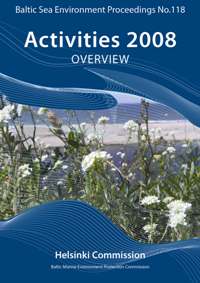Press release
HELCOM releases Annual Report on 2008 activities
 Helsinki, 11 June (HELCOM Information Service) – The Baltic Marine Environment Protection Commission (HELCOM) today released its annual report on 2008 activities.
Helsinki, 11 June (HELCOM Information Service) – The Baltic Marine Environment Protection Commission (HELCOM) today released its annual report on 2008 activities.
The report summarises the activities of HELCOM related to the protection of the Baltic marine environment over the period March 2008 to March 2009. It provides an overview of HELCOM’s assessments of current trends in the Baltic marine environment, as well as details recent HELCOM activities aimed at reducing pollution to the Baltic Sea, improving safety of navigation, as well as halting the decline in biodiversity.
“The year 2008 was one of new beginnings, intense activities, and accomplishments for HELCOM, says Anne Christine Brusendorff, HELCOM’s Executive Secretary. “It was a year when we launched the implementation of the strategic Baltic Sea Action Plan to radically reduce pollution to the sea and restore its good ecological status by 2021. This overarching programme of actions signals a new future for the troubled marine environment.”
The actions contained in the HELCOM Baltic Sea Action Plan are, to a great extent, epoch-making as HELCOM is pioneering some innovative new concepts for the Baltic. The programme provides a plan for implementing the ecosystem-based approach to the management of human activities in the Baltic. The plan focuses on the four most significant environmental issues in the Baltic: eutrophication caused by excessive inputs of nutrients; pollution by hazardous substances; biodiversity decline; and maritime safety.
The implementation of the HELCOM action plan officially commenced in April 2008, following the inaugural session of the Commission’s newly established Group to steer the Baltic recovery. One of the first key tasks of the Implementation Group was to elaborate a comprehensive list of municipal wastewater treatment plants and a list of agricultural pollution hot spots that do not fulfil the HELCOM requirements. This project is vital for the successful implementation of the plan. Inadequately treated sewage and agricultural run-off are the major sources of phosphorus and nitrogen inputs into the Baltic Sea responsible for its eutrophication. Therefore, the mitigation of excessive nutrient loads from these sources is recognised as one of the priority actions.
The year also saw many new successful projects and initiatives launched to support the implementation of the Baltic Sea Action Plan. In March 2008, HELCOM held the third international Stakeholder Conference on the Baltic Sea Action Plan, which focused on the involvement of international financial institutions (IFIs) in the implementation of the programme to restore the sea, as well as maritime spatial planning issues. Together with regional authorities, HELCOM also arranged several regional/national Stakeholder Workshops on the implementation of the plan. HELCOM considers these workshops as a crucial means to facilitate the elaboration of national programmes of action and development of prioritised lists of actions, and acquire financing to speed-up the implementation process.
Several major assessments were prepared in the past twelve months on eutrophication, biodiversity and nature conservation, hazardous substances, radioactivity, as well as on coastal fish. Additionally, the elaboration of an overarching, holistic assessment of the status of the marine environment was initiated. Two large projects, co-financed by the EU, were launched at the beginning of 2009. One aimed at considerably improving the readiness of the coastal countries to respond to major oil and hazardous substance spills (BRISK); the other focused on the identification of sources of the selected hazardous substances by screening in municipal and industrial wastewaters (COHIBA). Another crucial project for the success of the action plan – BALTHAZAR, launched in early 2009 with the financial support of the European Parliament pilot project facility - specifically aims at reducing the losses of hazardous substances and nutrients from point sources in St. Petersburg, Leningrad and Kaliningrad Oblast’. In 2008, HELCOM also made two submissions to the International Maritime Organisation calling for tighter international regulations to decrease nitrogen oxides (NOx) and sulphur oxides (SOx) emissions from ships.
Follow-up:
Click here to view the annual report.
To order your print copy, please call the HELCOM Secretariat: + 358 (0)207 412 649 or send an e-mail to info@helcom.fi.
Note to Editors:
The Baltic Marine Environment Protection Commission, usually referred to as the Helsinki Commission, or HELCOM, is an intergovernmental organisation of all the nine Baltic Sea countries and the EU which works to protect the marine environment of the Baltic Sea from all sources of pollution.
HELCOM is the governing body of the "Convention on the Protection of the Marine Environment of the Baltic Sea Area," known as the Helsinki Convention.
For more information, please contact:
Mr. Nikolay Vlasov
Information Secretary
HELCOM
Tel: +358 (0)207 412 635
Fax: +358 (0)207 412 639
E-mail: nikolay.vlasov@helcom.

